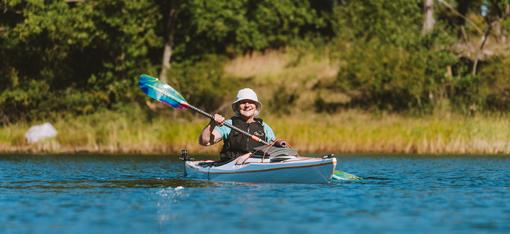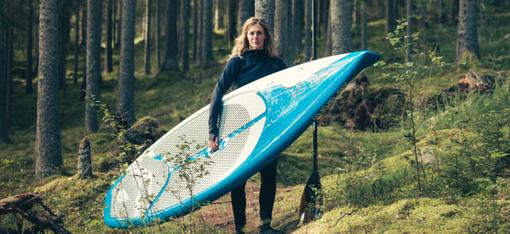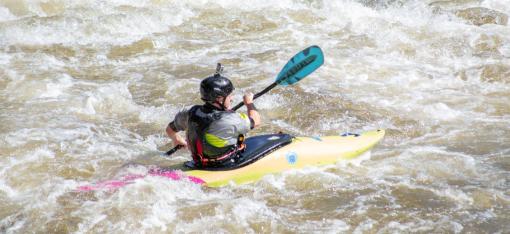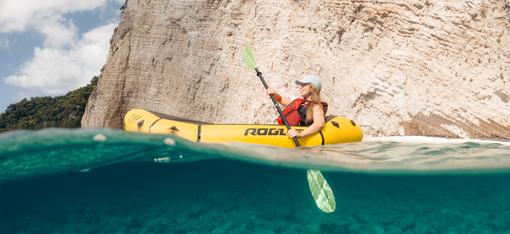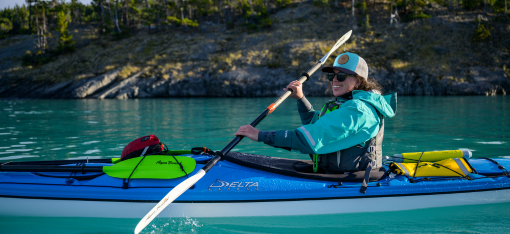Exploring Sörmland, Sweden by Kayak and Canoe
6-minute read
Michael O’Dwyer is on a mission to explore his corner of Sweden by canoe and kayak—and to inspire others to do the same. He’s compiling his experiences into a guidebook to showcase the rich paddling opportunities the region has to offer.

There are 100 km of coastland and archipelago in Sörmland—this is Beten
Originally from Ireland, Michael has lived in the Södermanland region of Sweden—affectionately known as Sörmland by the locals—for the past 16 years. He has embraced the deep connection to nature that’s so integral to Swedish culture, and he appreciates the active lifestyle that encourages people to get out and do, rather than sit back and watch.
When he’s not working in his goldsmithing workshop, Michael spends his time with his wife and children immersed in the forests, lakes, and coastal areas that surround their home.
He’s currently writing a paddling guidebook that will highlight routes for canoeing the region’s inland lakes and rivers, as well as sea kayaking along the Sörmland coast and through its stunning archipelago.

Exploring the nooks and crannies of the archipelago
We recently had the chance to sit down with Michael to learn more about this beautiful part of the world, his passion for paddling, and his upcoming book. Here’s our interview with him:
AQUA BOUND: Tell us about Sörmland and why it’s such a great place for paddlers.
MICHAEL: I live about 50 miles outside of Stockholm, in Sörmland—one of the most wildlife-rich regions in Sweden. In fact, it may be the most abundant in Scandinavia, perhaps even in all of Europe. We're surrounded by forests, hiking trails, an incredible network of lakes, and a stunning coastline that’s perfect for sea kayaking.

Pulling the kayaks up for a break in Rågö
The Stockholm archipelago is massive, with somewhere between 20,000 and 30,000 islands—depending on how you define an island. The coastline stretches roughly 200 kilometers in length and extends 50 to 60 kilometers out into the sea. That means there’s essentially unlimited sea kayaking available just within Stockholm County.
My guidebook will focus on Sörmland, which has a much shorter coastline by comparison. While it’s not exactly undiscovered, it’s not the first place Swedes think of when it comes to kayaking. Just south of us is the county of Östergötland, home to the well-known St. Anna archipelago (St. Anna’s skärgård).
As a result, Sörmland is often overlooked—but it really shouldn’t be. Its coastline is around 100 kilometers long, and the archipelago here isn’t as deep. You can reach the outer islands within minutes, unlike Stockholm, where it can take the better part of a day to paddle that far.
Another advantage is that shipping traffic is minimal—mainly because the only major port is located far to the south. That makes the waters much more peaceful and enjoyable for kayakers. Plus, the area is packed with interesting sights—historic sites, small harbors, and hidden gems—offering a lot of value in a relatively compact area.
AQUA BOUND: What will your guidebook include?
MICHAEL: Sweden as a whole—including Sörmland—has a rich history dating back to the Industrial Age. The country grew wealthy from its iron industry, especially through the production of cannons and weapons. The remnants of that era are still visible throughout the region.
When writing about canoeing and kayaking, there’s only so much you can say about the forest, the next bend in the river, or another island in the archipelago. But when you start to include historical buildings, old mines, and former foundries, the story becomes much more compelling.

Not necessarily a common sight while sea kayaking! (Hartsö)
Sörmland offers that perfect blend of history and culture, all set within a beautiful natural landscape.
I’ve already written a guidebook for gravel cycling in Stockholm, and in that book I included historical and cultural landmarks, as well as recommendations for local cafés, outfitters, shops, and other points of interest for cyclists. I plan to take a similar approach with this paddling guide.
As far as I can tell, no one has ever published a dedicated guidebook for paddling in Sörmland—whether for sea kayaking or canoeing—which is surprising, considering how accessible the area is. Within a two-hour drive, you have access to around 40% of Sweden’s population—that’s about four million people.

Sea kayaking is very popular in Sweden, but no one has yet published a guidebook for the Sörmland region where Michael and his family live
A while ago, there was a European initiative that awarded grants to help revive culturally significant coastal communities across Europe. Our region of Sweden benefited greatly from this project. Part of the kayaking exploration was about uncovering what was out there and mapping it.
It was relatively easy to locate designated fire pits, but we were also pleasantly surprised by the number—and quality—of the outdoor toilets. Many even had toilet paper stocked! They’re all remarkably well maintained.

The campsites along Sörmland’s coast are in nice condition, like this one in Beten
In the more popular spots, local communities even provide free firewood, which helps prevent people from cutting down trees. There's a deeply rooted culture of environmental care here.
In Sörmland, while there are plenty of popular coastal destinations, there’s still no kayak guide available. That’s exactly the gap I’m aiming to fill.
AQUA BOUND: Explain “Allemansrätten” and how it affects how you write your book.
MICHAEL: Allemansrätten, or the “right to roam,” is a deeply-rooted principle throughout Scandinavia. It’s a wonderful privilege for hikers, campers and paddlers, as it allows people to explore nature freely—within reason—without needing special permissions.

A beautiful campsite on the coast of Sävö, Sweden
However, it’s also contributed to a certain mindset that “the outdoors should be free.” As a result, many people are reluctant to pay for guided experiences, and there are fewer outdoor clubs and organizations than you might expect in a country so oriented toward nature.
Allemansrätten also brings some complexities when it comes to commercial guiding—especially around group sizes and what qualifies as acceptable under the law. It’s not a single, simple law but rather a nuanced collection of by-laws and traditions that require careful interpretation and respect.
With this guidebook, I aim to follow all relevant rules and regulations for every route. My hope is that by doing so, various organizations and stakeholders will be more likely to promote it.
While waterways are always open to the public under Allemansrätten, I’ll be careful to only include public access points—such as designated starting and ending locations, car parks, official swimming areas, nature reserves, and similar public infrastructure. This ensures the book is both legally sound and respectful of the natural and cultural landscapes it highlights.
AQUA BOUND: How are you involving your family and friends in this project?
MICHAEL: Outdoor activities with family are a normal part of life in Sweden. I have five kids who are now old enough to really enjoy the outdoors, and they love it. So my family often comes along on canoe routes. One of my main paddling partners is my son, Vidar. He’s been diagnosed with ADHD, but he absolutely thrives in nature. It’s incredibly therapeutic for him—he’s his best self when he’s out there. And for me, it’s a special way to bond with him.

A beautiful, calm morning on the sea, Lacka
I first learned to kayak a few years ago from a Norwegian paddler near Lofoten, in northern Norway. I took a course with him, came home, and bought my first boat. Over the years, I’ve rotated through different outdoor passions—bikepacking, gravel riding, hiking, and Nordic skating—but lately, I’ve come back to paddling in a big way.
I even introduced some of my cycling friends to kayaking and invited a few of them to join me in exploring the Sörmland coastline. We spent six days paddling, documenting routes, and collecting material for the guidebook.
At the same time, I’m making an effort to connect with the local canoeing and kayaking community—building friendships, sharing stories and posts, and letting people know about this project.
I’m actually dyslexic, but I’ve recently discovered a love for writing. I still have a lot to learn, but I work hard at it and want to keep improving. I’m not doing this for financial gain. This book project is about family, exploration, inspiration—it’s my way of encouraging people to get outside, to experience nature, and to give something back to the community that has given so much to me.

Paul and Björn on their 6-day trip (Rågö, Sweden)
Follow Michael on Instagram to more of his paddling photos and videos.
All photos courtesy of Michael O’Dwyer
What paddling questions can our friendly Customer Service team help you with? Contact us at 715-755-3405 or sales@aquabound.com, or choose our online chat option.
More for you...

